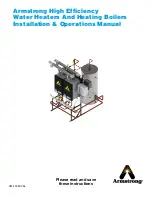
North America • Latin America • India • Europe / Middle East / Africa • China • Pacific Rim
armstrong
international.com
Designs, materials, weights and performance ratings are approximate and subject to change without notice. Visit
armstrong
international.com for up-to-date information.
10
3/4"=1'
Reference dimensions are ± 10%
All dimensions are ± 1"
Custom
Dwg No.
Customer / Job name:
Scale:
Description:
Drawn/
Revised by:
Checked/
Apv. by:
Revision:
MM/DD/YY
Date:
Pre-Installation Requirements
The ABH models 299–599 are designed to be installed using a factory
designed and supplied rack or frame (see Figure 1.3 for details). Consult
factory for details of wall mount bracket. It can be installed in alcoves,
basements, and utility rooms, as well as standard equipment rooms.
Choose a location for your ABH, centralized to the piping system, along
with consideration for Electrical (page 12), Gas Connection (page 14),
Venting (page 19), and Condensate Drain (page 28).
The ABH heat exchanger must be level as installed, and the mounting
surface must be designed to support the weight (see previous page,
Table 1.2 for weights). Be sure the appliance is adequately secured to the
mounting surface.
The front cover is secured by a threaded screw and two clasp style latches;
it can only be installed one way.
When removing the front cover of the ABH
unit, you must make sure all electric power to the appliance is turned
off.
Then remove the screw at the bottom of the panel, undo the latches and
remove the cover (see Figure 1.4 on the next page).
If the ABH is set up for liquefied petroleum (LP) gas, some geographic
areas follow the Uniform Mechanical Code, section 304.6, “Liquefied
petroleum gas burning appliances shall not be installed in a pit, basement
or similar location where heavier-than-air gas might collect. Appliances so
fueled shall not be installed in a below grade under-floor space or basement
unless such location is provided with an approved means for removal of
unburned gas.”
Note:
A water chemistry analysis should be performed prior to any
installation. If the water quality exceeds any of the following levels, then a
water chemistry analysis must be performed:
• Water hardness can be no more than 12 grains (205 ppm or mg/l)
• TDS (total dissolved solids) can be no more than 450 ppm or mg/l
• PH—below 6.5 or above 7.5
For total combined hardness over 15 grains (250 ppm or mg/l) or longer
pipe lengths, contact Armstrong Hot Water, Inc. for correct pump sizing.
Combined, the hardness and TDS can be no more than 450 ppm. Our
internal term for this is the TCH (Total Combined Hardness).
Recommended Service Clearances
3/4"=1'
Reference dimensions are ± 10%
All dimensions are ± 1"
Custom
Dwg No.
Customer / Job name:
Scale:
Description:
Drawn/
Revised by:
Checked/
Apv. by:
Revision:
MM/DD/YY
Date:
Zero Clearance
from back of unit
to wall
18
"
(457.2mm)
C
learance
from
bot
tom
of unit
24"
(609.6mm)
Clearance
from
front
of unit
12"
(305mm)
Clearance
from top
of unit
3"
(75.2mm)
Clearance f
rom
side
of unit
Figure 1.2 - ABH Clearances
Note: The ABH is rated at zero clearance to
combustibles.
Figure 1.3 - ABH Mounting Detail
General Information - continued











































